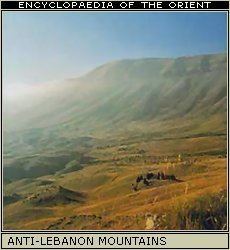 | ||
Mountains Mount Hermon, Mitzpe Shlagim, Mount Betarim, Mount Varda, Har Dov | ||
The Anti-Lebanon Mountains (Arabic: جبال لبنان الشرقية, Jibāl Lubnān aš-Šarqiyyah, "Eastern Lebanon Mountains"; Lebanese Arabic: جبال الشرقية, Jibāl aš-Šarqiyyah, "Eastern Mountains") are a southwest-northeast-trending mountain range that forms the majority of the border between Syria and Lebanon. The border is largely defined along the crest of the range. Most of the range lies in Syria.
Map of Anti-Lebanon Mountains, Syria
Its Western name Anti-Lebanon comes from the Greek and Latin Antilibanus, derived from its position opposite and parallel to the Mount Lebanon range. It ends in the south with Mount Hermon, which borders on the Golan Heights; the Golan Heights are a different geological and geomorphological entity, but geopolitically they are often regarded together with the southern slopes of Mount Hermon, both being part of the Israeli-controlled Golan region. To the west of the Anti-Lebanon lie valleys that separate it from Mount Lebanon in central Lebanon: Baalbek's Beqaa Valley in the north and the Hasbani River valley in the south. To the east, in Syria, lies the Eastern Plateau, location of the city of Damascus.
The Anti-Lebanon range is approximately 150 kilometres (93 miles) in length. To the north, it extends to almost the latitude of the Syrian city of Homs. To the south, the range coalesces with the Golan Heights plateau but includes the highest peaks of Mount Hermon (Jabal el-Shaykh, in Arabic), at 2,814 metres, and Ta'la't Musa, at 2,669 metres. These peaks are snow-covered for much of the year and are located on the Lebanese-Syrian border.
There are various endemic flora found and named after the region, (having a Latin specific epithet) including, Euphorbia antilibanotica, Teucrium antilibanoticum, Valerianella antilibanotica, and Iris antilibanotica.
